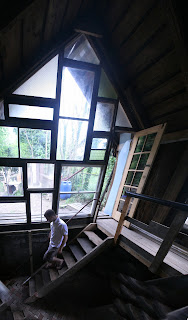From October 22 to 26, Flint Public Art Project invited artists and designers from around the country to work with groups to landscape a new orchard, design and build seating for a bus stop, and create small-scale physical models to illustrate changes residents would like to see in their neighborhoods. On the opening night of the conference, participants share the results of these collaborations. James Rojas presents his planning workshops with five groups in the city, Alex Gilliam shares his design-build interventions with Job Corps, Susannah Drake is joined by Derek Williams of Peace Mob to argue for sustainable reuse of vacant lots, and Bill Hammond discusses the Salem Community Development Corporation mural project. Unified Sisters perform. Arlow Xan plays musical interludes.
CUT: Reclaiming Former Industrial Sites, Oct. 27
Former factories sites can be transformed into public spaces, museums, and thriving communities. See how cities around the world are reclaiming abandoned industrial areas, restoring plants and wildlife, recovering their industrial history, and reconnecting people to abandoned spaces. Center for Community Progress fellow Steve Montle and environmental engineer Joel Parker report on the city's efforts to remediate Chevy-in-the-Hole, a 130-acre former GM manufacturing plant in the heart of the city. Jill Allen of Stoss Landscape Urbanism and Susannah Drake of dlandstudio share examples from their own practices and historical precedents.
Growing urban agriculture, Oct. 27
In cities across the country, residents are reclaiming vacant lots to grow food, provide job training, educate young people, and create safe public spaces. How can city governments, citizens, and partners support and expand this movement? Learn how urban farmers and gardeners in Flint, Toledo, and New York City are gaining access to land, soil, and other resources to strengthen their communities. Speakers include Greg Gaines of Mr. Rogers Garden Program, Stephen Arellano, urban food systems consultant, and Jerome Chou, editor of Five Borough Farm. Arlow Xan performs musical interludes.
Re-using abandoned buildings and vacant lots, Oct. 27
How can cities and residents turn devalued land into opportunities? Discarded materials, public events, temporary spaces, and other unconventional strategies can inspire possibilities for reusing vacant buildings and land. Doug Weiland, executive director of the Genesee County Land Bank, describes initiatives to manage vacant properties, and artists and architects present examples of beauty made from ruins and activated empty spaces. Speakers include Daniel D'Oca of Interboro Partners, Kyong Park, founder of Storefront for Art and Architecture, and Matthieu Bain and Andrew Perkins of the Dwelling on Waste project, with CUP founder and Newark chief urban designer Damon Rich serving as moderator. Arlow Xan performs musical interludes.
Planning and process for legacy cities, Oct. 27
Master plans are the road map to a city’s future. They point residents, businesses, and city governments toward a common destination. An inclusive, accessible process can bring communities together to imagine what a city can be. Planners and architects working in Detroit, Newark, and Philadelphia compare notes with Flint’s Chief Planner Megan Hunter on the challenges and opportunities their cities face and the best ways to engage publics.

















































